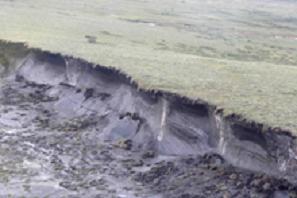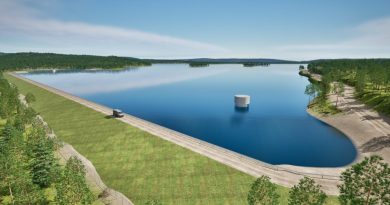Frigid April, balmy October; in Alaska yo-yo temperatures are normal

Loren Holmes photo
Days before Halloween, when Alaskans would normally be awaiting the ski and snowmachine season, Anchorage weatherman David Snider was contemplating how he might have to mow his grass one more time.
Some lawns were still green. Big rafts of yet-to-migrate waterfowl were paddling the still-ice-free waters of Westchester Lagoon in the middle of the 49th state’s largest city as the warmest October since 1915 entered its final day. Some city residents were scratching their heads and thinking, “Global warming?”
Just a few months earlier, though, the phrase “climate change” meant an unusually cold April and a snow season that continued well into May.
As Sarah Palin, the state’s former governor, might tweet: “WTF up w/Alaska weather?” Suddenly Alaska’s normal summer season of May to September was looking more like June to October.
Could it be the seasons are changing in more ways than one in the north?
‘That dreaded variability’
“Probably not,” said Rick Thoman, the regional climatologist for the National Weather Service. “It’s an anomaly…. that dreaded ‘variability.'”
Or at least he’s hoping it’s an anomaly. With Alaska weather, there’s really no telling. The only way anyone will be able to determine for sure that Alaska’s seasons are shifting is if years from now June to October is our new summer. Similar uncertainty applies to the fallout from global warming in a state known for variable weather. This year, the Weather Service noted, Alaska had “September’s climate in October.”
“Mainland Alaska had the warmest mid-October since at least 1938,” the agency reported. Records were set all over the place. Anchorage is on track for the warmest October since 1915. It’s easy to think “global warming.”
But wait a minute. September was colder than normal in many places, according to the Alaska Climate Research Center. Fairbanks was more than a degree colder than then the long-term mean; Anchorage more than half-a-degree colder; and Delta Junction, which set a record for October warmth, was a chilly 1.4 degrees below the norm only a month before.
And then, of course, as Thoman points out, there was April. The normally calm and objective Alaska Climate Center actually used the word “astonishing” to describe the state’s weather six months ago.
“Winter lingered across Alaska in April with seasonably colder-than-normal temperatures … The mean temperature of all first-order stations for April was 24 degrees Fahrenheit, 6.9 degrees below the long-term mean of 30.9 degrees. Interior stations reported the most extreme deviations from the expected temperatures with Delta Junction topping the list with an astonishing negative deviation of 15.2 degrees,” it reported.
Delta Junction must be the Alaska land of extremes with an April 15.2 degrees colder than the norm followed six months later by a record-high that topped the previous warmest day in October by an eye-popping 19 degrees.
What’s going on here?
Wacky jet streams
Well, for one thing the jet stream has gone a little nuts, which is affecting the weather around the planet. “When you get these big ups and downs (south to north flows) in the jet stream, it tends to propagate around the globe,” Thoman said.
The north-flowing jet stream that pushed big storms and a lot of warm air out of the Pacific Ocean into Alaska in October had a parallel on the other side of the planet, where a north-flowing jet stream pushed big storms and a lot of warm air out of the Atlantic Ocean into the United Kingdom.
A report on the situation filed by The Guardian newspaper from southern England sounded an awful lot like the reports filed from the Anchorage Hillside this month: “The Met Office reported winds of 93 mph on the Isle of Wight in the early hours of Monday…. Winds of more than 80 mph could leave a trail of destruction across large parts of the UK, knocking down trees and causing major structural damage and power cuts.”
Global warming is thought to have increased the intensity of these storms because the atmosphere can gather more energy from warm ocean waters than from cold ocean waters.
But while Alaska and England were getting the warm push from the jet stream, the American Midwest was getting the cold backlash. Nobody there was thinking “global warming.” Snow fell early and in unusual quantities across the northern Great Plains. U.S. News and World Report noted more than 43 inches of it fell in Lead, S.D.
It’s all a part of weather gone wild. So what happens next?
Nobody knows, confessed Thoman, who said he’s been pestered by people wanting to know if the warmest October in Alaska in decades will mean a warm winter, too. Don’t count on it, he said. In 1938, Interior Alaska weather stayed warm into December, but then it went right back to the normal Alaska frigid cold. Thoman is, however, expecting temperatures to stay above normal for some weeks yet.
Given the lack of ice in the Bering Sea, and a persistent block of high-pressure air over the Pacific that continues to direct west-tracking weather systems north toward Alaska, the state should continued to luxuriate in comparatively warm air, meaning that while it might get increasingly chilly, you won’t need to plug in your car for a while yet.
‘It’s only Halloween’
But, Thoman warned, both temperatures and precipitation will start “trending back to normal, and normals are falling pretty fast this time of year.
“It’s only Halloween. Winter’s got a long way to go. This is likely to continue for another month, but snow is going to come.” Snow was falling on Thursday in Fairbanks, though the 33-degree temperature remained 13 degrees above the normal high for Oct. 31. Anchorage was at 43, 10 degrees above its normal high.
Still, the forecast for the state’s largest city, too, called for “rain and snow.” The seasons are inevitably changing. They’re just not changing in the predictable manner humans have come to expect.
Contact Craig Medred at craig(at)alaskadispatch.com



